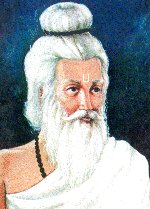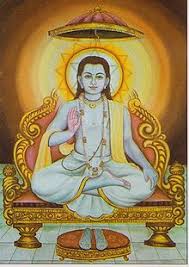|
Yajnavalkya was acclaimed rishi or scientist in period 8th to 7th century BC. Once, Raja Janaka held a debate on spirituality which was attended by a large of sages and rishis including Yajnavalkya. During a debate, Vidagadha Sakalya raised several questions relating on types and number of gods. The debate has been mentioned in Brihadaranyaka Upanishad.
Yajnavalkya explained the cause, types and the number gods and their basis. The details of questions raised and replies are as under: 1. How many gods are there? Vidagadha Sakalya asked the question repeatedly. Answer: Yajnavalkya relied successively that number of Gods are: · 3003, 303 - As many as are mentioned in the (group of Mantras known as) Nivid of the hymn of praise addressed to the Visvedevas (Parmatma) viz. three hundred and three, three thousand and three. Many form of gods’ manifest the man's desire which all emanate from the one vital force of material desire are dealt with. · 33 - The various powers praised in 3003 & 303 are in reality only thirty-three gods. The eight Vasus, the eleven Rudras, the twelve Adityas, Indra and Prajapati make up the thirty-three. o Fire, the earth, air, the sky, the sun, heaven, the moon and the stars, these are the Vasus. Vasus or energies are said to enable the desire that manifests the forms of all that live as well as all the objects of the universe. o The ten organs in the human body (five gnanendriyas, and the five karmendriyas), with the mind as the eleventh. When they depart from this mortal body, they make (one's relatives) weep. Because they then make them weep, therefore they are called Rudras. o The twelve months (are parts) of a year; these are the Adityas. Within creation all is subject to change and transience, this mutability we call time and mortality. Time came into being with Creation. The Adityas represent entropy (energy balance) as the twelve months that represent the time effect with mortality. o The cloud is Indra, and the sacrifice is Prajapati. Strength and sacrifice are the means of rites and rituals. These are included because rites and rituals are regarded as a part of the desire for further creation, so the cause and maintenance of Creation (which is the purpose here to reveal) must be shown to encompass such ritual (desire). · 6 - Fire, the earth, the air, the sky, the sun and heaven these are the six. · 3 - Three worlds, because in these all those gods are comprised. · 2 - Matter and the vital force. · One and a half - The vital force (material desire) represented by "The (air) that blows" (the breath of life, symbolizing the desire that maintains the life experience itself). It is one and a half because through its presence all this attains surpassing glory. · One - The vital force (Hiranyagarbha, Prana); it is Brahman, which is called that (Tyat). Vital Force also as air or prana has been explained to be the initial energy or movement from original desire from which all of these gods, deities or energies followed. The vital force named in this verse as Brahman does not mean the Absolute Brahman, The Non-Dual Self. This Brahman is the conditioned Brahman of material creation. This Brahman is endowed with attributes by the ignorant who seek reality in Creation. Ignorance is the forgetting of our Unity with the Absolute. 2. Vital force symbolizes the desire to Create and maintain worldly existence. Vital force, the one cause of all the worldly gods. The material form of the body was created from this world and will again decompose back to the earth. The material universe will eventually return to rest when creation is subsumed as the Absolute Knowledge alone. Vital force symbolizes the desire to flourish through offspring. The ultimate resort of the entire body and organs is the being who is identified with lust. 3. The abode or support or material for a vital force will naturally be the earth. The vital force itself is the very product of the mind, ego and Manas. 4. According to yogic philosophy, the human mind been classified into four categories: buddhi (intellect), manas, ahamkara and chitta. Manas means sensory, processing mind, Chitta is for storage of impressions, Ahamkara means "I-maker" or Ego and Buddhi which knows, decides, judges, and discriminates. It is due to being led by Manas that delusion and ignorance cause the seeing of duality as reality. Manas needs to be supervised, not allowed to be a guiding light. The intellect led by Manas leads to delusion and ignorance. Higher Divine Truth is seen through mind controlled by Buddhi. 5. Within this universe, duality of justice and injustice exist. The sacrifice ritual is conducted within the realm of Dharma and righteousness through which justice is obtained. It is the priest that officiates and gives validity and authority to a sacrifice ritual and the correct remuneration of the priest completes the correct procedure. Remuneration rests on faith which is guided by mind and supported by intellect. This faith is the very belief of the ignorant in a deity vital force that supports their individual rites and desire for reward from a divinity of duality. 6. Mind rests in Prana. Prana rests in apana (down breathing). Apana rests in Vyana (back breathing). Vyana rests in Udana (out breathing). Udana rests in Samana. These are the eight abodes (the earth, &c.), the eight worlds (fire, etc.), the eight gods (the immortal food, etc.), the eight persons (the corporeal, etc.). 7. Water here represents the organs of the body. Vital force sustains the desire for physical manifestation. Water sustains the body; the body is the abode of the vital force. Who is his deity'? 'Varuna (rain). Prajapati (the father) represents the renewal or continuation of creation through the desire for wife, Son, wealth and fame. 8. Colors symbolize the appearance of duality through the various forms of creation whose instrument of vision is the eye. Sunlight enables the seeing of colours form and duality. That described as residing in the sun also has the status of deity or god. Sense of hearing provides information it is due to all the senses confirming the world of duality. It is the being who is identified with the ear and with the time of hearing. 9. Distance in all the directions (The quarters) of the universe also represent deity. East direction is named seeing the sun. The sun is elevated to a deity by those seeing reality in Creation. Existence of the sun exists is supported by the sense of sight and the eye represents the proof of the sun’s existence. Eye sees different colors. Colors are in mind. South direction is associated with the deity, Yama (the god of justice). 10. West direction is associated with the deity, Varuna (the god of rain). To support life rain becomes water and it is from water that rain is produced. Water comes with Creation. Creation arises from the seed. 11. North direction is identified with the deity, Soma (the moon and the creeper). The ritual and the priest produce soma or liquid to enable the fruits of the ritual. Soma rests on initiation and initiation rest on truth. This truth is the truth as reported by the senses. One knows truth through the mind. 12. Fixed direction (Zenith) is identified with the deity, fire. Fire rest on speech. Speech acts of Creation by speaking the objects of desire. Speech is guided by mind as it sees duality with its needs and desires as real. Reference:
0 Comments
Sri Nimbarakacharya – Dvaitadvaita Philosophy
Sri Nimbarkacharya was born in Pandarpur in Andhra Pradesh in 12-13th century. Sri Nimbarka was devotee of Krishna and spent his time mostly in Mathura, the birth place of Krishna. He wrote small work of ten verses known as Dasa-Sloka, giving a short exposition of his doctrine for beginners. Nimbaraka expounded the philosophy of Dvaitadvaita – duality in unity. He basically adapted the doctrine of Bhedabheda of Bhaskara. According to him, Brahman has innumerable auspicious attributes but without any particular form. He transforms Himself into the world of duality and change, without losing His entity as the Absolute and unitary Being. The Jiva in his real nature is one with Brahman, but gets differentiated from Him in the state of bondage by what is called the Upadhis or adjuncts of body-mind. But in liberation, Jiva is becomes with Brahman, as a river becomes one with ocean when it enters it. According to Bhaskara, by performance of the duties imposed on one by the Vedas without any desire for their duties imposed on the practice of meditation on Brahman and the Jiva’s oneness with Him, the Jiva will be able, by the strength of his aspiration for freedom, to release him from the bondage imposed by Upadhis. Bhaskara’s system does not preach devotion to any form of the Deity, nor does it affiliate itself with any personalistic cult. Nimbarka’s Dvaitadvaita philosophy is as under: Brahman is only independent entity. He is known by several names as Parmatman, Bhagavan, Isvara, Rama, Krishna and Purushottama. He is free from the five kinds of imperfections (Klesas) viz. ignorance, egoism, attachment, hatred and fear of death. He is omniscient, omnipotent and His will is always accomplished (Satya-sankalpa). He is free from law of karma. He is Nirguna (without three gunas of Prakriti – Sattva, Rajas & Tamas). He possesses the six unique qualities – Jnana (knowledge to perceive everything), Shakti (Power to make everything), Bala (Strength to support world), Aishvarya (Sovereignty), Virya (tireless energy) and Tejas (Prowess to suppress opposing forces).
Reference: Bhakti Schools of Vedanta – by Swami Tapasyananda, Sri Ramakrishna Math, Chennai. Philosophy of Sri Madhvacharya – the Dvaita
Sri Madhvacharya, who lived during 1238-1317 in Karnataka, propounded the philosophy of Realism, the Doctrine of the Two i.e. Dvaita. It accepts two entirely separate substances, the independent reality (God) and the Dependent reality (the Jivas, Nature and other allied categories). Consciousness is always bi-polar. There must be a knower (Jnata) at one end, and an object (Jneya) at other end. The Dvaita is further elaborated through fivefold difference viz. Jiva and Jiva; Isvara and Jiva; Isvara and Jada or inanimate substance; Jiva and Jada: Jada and Jada. The highlights of the philosophy are as under: Dvaita doctrine of Madhva has recognized ten ultimate categories as under:
Supreme Being (Brahman):
Jiva (Individual soul):
Prakriti: Prakriti is dependent on Brahman. (As against, Samkhya’s philosophy that Prakriti is absolutely independent entity and philosophy of Advaita that world is only provisional reality which is sublated when the Truth is realized.). Space and Time: Both unmodified space and Time are not perceived through any of the sense organs by the Saksi (witness), the intuitive power of the Atman, directly. In deep sleep when all the senses and mind are absolutely at abeyance, the saksi intuits bare ego, bare time and bare bliss. As no sense experience is there, it cannot be an ordinary perception and for that reason, not an inference. The evidence of Saksi alone certifies it. Both time and space are infinite but also infinitely divisible.
Avidya or Ignorance: The sense of an independent self-centered existence is called Avidya, the Svarupajnana (the ignorance of one’s nature). It is the basic cause of the Jiva’s involvement in the miseries of Samsara consisting in repeated births and deaths. The locus of Avidya is said to in Jiva. Reference: Bhakti Schools of Vedanta – by Swami Tapasyananda, Sri Ramakrishna Math, Chennai. |
Archives
July 2024
Categories |


 RSS Feed
RSS Feed